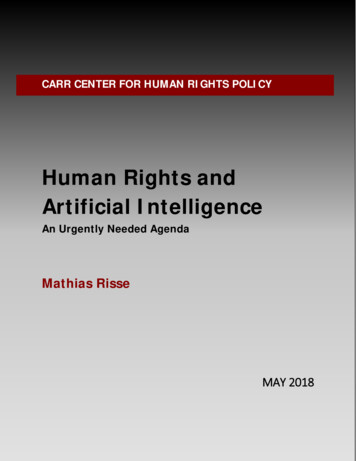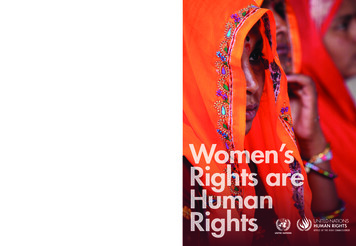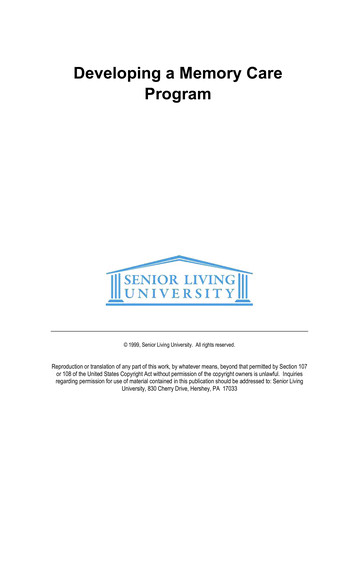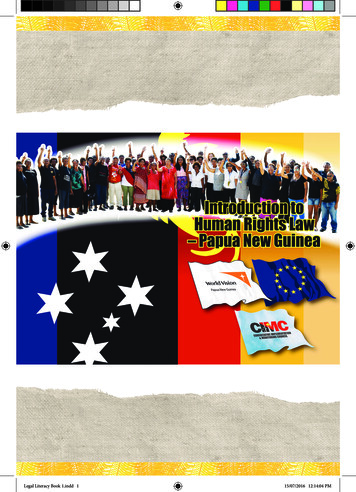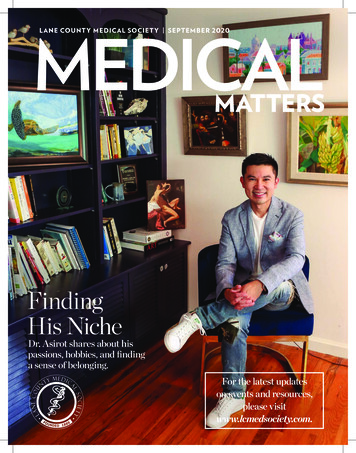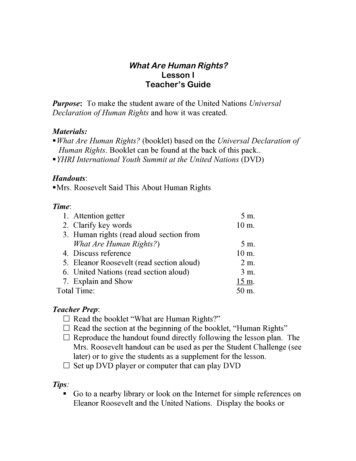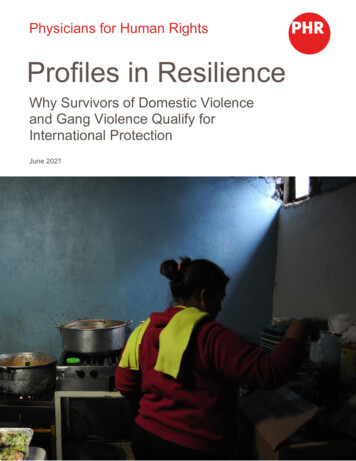
Transcription
Physicians for Human RightsProfiles in ResilienceWhy Survivors of Domestic Violenceand Gang Violence Qualify forInternational ProtectionJune 2021
37810123442434548ContentsAcknowledgmentsExecutive gal and otesThis report was researched and written by faculty and student researchers at the University ofCalifornia, Los Angeles (UCLA), in collaboration with Physicians for Human Rights (PHR) staff.Eleanor Hope Emery, MD, former member of the faculty at UCLA and now instructor of medicineat Harvard Medical School and program officer at Cambridge Health Alliance’s Center for HealthEquity Education & Advocacy, co-led the development of the overall study design and thedevelopment and implementation of the study’s methods, including the creation of the codingtool used for data abstraction. She also assisted in data abstraction and qualitative analysis andled the preparation of the manuscript. Adam Richards, MD, PhD, MPH, former member of thefaculty at UCLA and now associate professor of global health at the George WashingtonUniversity Milken Institute School of Public Health, co-led the development of the overall studydesign and the development and implementation of the study’s methods, including the creationof the coding tool used for data abstraction. He was responsible for statistical analysis andreporting and assisted with data abstraction, qualitative analysis, and preparation of themanuscript. Mehar Maju, MPH, graduate of the UCLA Fielding School of Public Health,contributed to the implementation of the study’s methods and assisted in data abstraction,qualitative analysis, and preparation of the manuscript. Kate Coursey, medical student at theDavid Geffen School of Medicine at UCLA, assisted with data abstraction, qualitative analysis,and preparation of the manuscript. Cameron Brandt, MPH, MA, public health specialist at theUCLA Fielding School of Public Health, assisted with data abstraction, qualitative analysis, andpreparation of the manuscript. Jamie S. Ko, MPH, medical student at the David Geffen School ofMedicine at UCLA, implemented the coding tool via Qualtrics and assisted with data abstraction.Kathryn Hampton, MSt, PHR senior asylum officer, assisted with the development of the overallstudy design, the development and implementation of the study’s methods, and with qualitativeanalysis. She also drafted the legal analysis and policy recommendations.The authors would like to thank the Los Angeles Human Rights Initiative, a student-runorganization at UCLA that provides pro bono forensic evaluations to asylum seekers, for codingthe affidavits and making this study possible. The authors would like to acknowledge thefollowing people for their contribution to the development of the coding tool used for dataabstraction in this project: Neela Chakravartula, Sonya Gabrielian, Hajar Habbach, Roya IjadiMaghsoodi, Taylor Kuhn, Arash Nafisi, Altaf Saadi, Joe Shin, and Aparna Sridhar. The authorswould like to acknowledge the following people for their assistance with data abstraction for thisproject: Hala Baradi, Catherine Bradley, Gabrielle Daso, Kendall Dunlop-Korsness, JennyHuang, Preeti Kakani, Esther Kim, Victoria Lee, Leslie Ojeaburu, Jenna Paul-Schultz, andSophia Taleghani.Cover: A woman whofled Honduras with herfamily after her husbandwitnessed a murder andthe family was attackedby armed men affiliatedwith a local gang.Photo: PHR photo libraryThe report benefitted from review by PHR staff, including Michele Heisler MD, MPA, medicaldirector; Ranit Mishori, MD, MHS, senior medical advisor; Karen Naimer, JD, LLM, MA, directorof programs; Joanna Naples-Mitchell, JD, U.S. researcher; Michael Payne, senior advocacyofficer; Cynthia Pompa, asylum officer; Elsa Raker, asylum program associate; Susannah Sirkin,MEd, director of policy and senior advisor, and Raha Wala, JD, director of advocacy.The report also benefitted from external review by PHR board member Donna Shelley MD, MPH.The report was edited and prepared for publication by Claudia Rader, MS, PHR seniorcommunications manager, with assistance from Alissa Flores, communications intern. HannahDunphy, digital communications manager, prepared the digital presentation.NOTE: The photographs included in this report were taken during the course of a researchproject for a PHR report entitled “’If I went back, I would not survive.’ Asylum Seekers FleeingViolence in Mexico and Central America,” which was based on medical evaluations conductedby some of the same researchers who wrote this report. While the people depicted are not thesame individuals cited in this report, their stories and health outcomes are illustrative of thebroader trend uncovered in this research project.Profiles in Resilience: Why Survivors ofDomestic Violence and Gang ViolenceQualify for International ProtectionPhysicians for Human Rightsphr.org2
Executive SummaryIntroductionAlthough protection for refugees is a longstanding U.S. legal commitment underfederal and international law, immigration policy has become a deeply politicizedtopic in the United States in recent years. Domestic violence and violence byorganized gangs represent a major cause of forced displacement for thosearriving at the U.S. border. Yet these forms of persecution are viewed skepticallyby some policymakers who favor restricting immigration in spite of U.S. legalobligations to ensure the right to seek asylum.Extensive data demonstrates that the increase in migration from Central Americato the United States in the past decade has been triggered by physical and sexualviolence, death threats, and other abuses by organized gangs, domestic abusers,and government authorities, resulting in high levels of physical and psychologicaltrauma. The Trump administration dismissed these claims as “meritless” andasylum seekers as “fraudsters” who exploit the “loophole” of asylum, alleging thatthey are actually criminals. Former attorney general Jeff Sessions flouted decadesof domestic and international legal precedent by issuing a blanket statement, in asingle case, that domestic and gang violence survivors will generally not qualifyfor asylum. This decision had the immediate impact of increasing denials ofCentral American asylum claims, in line with the political goals of the Trumpadministration to deter migration from Central America.Research and methodologyA large proportion of Physicians for Human Rights (PHR) clients, who areasylum seekers receiving pro bono forensic evaluations, are survivors of domesticand gang violence. A research team, comprised of faculty from the University ofCalifornia, Los Angeles (UCLA), graduate students from the UCLA FieldingSchool of Public Health, medical students at the David Geffen School of Medicineat UCLA, and PHR staff, analyzed 132 medical-legal affidavits resulting frommedical and psychological evaluations of asylum seekers to capture thecharacteristics of the harms they experienced. The study also explored descriptivestatistics that could expose discriminatory patterns of harm that were notcaptured through the qualitative analysis. Our hypothesis was that the physicaland psychological findings in medical-legal affidavits would bring new insightsthat could inform efforts to change asylum policies.Research findings: Significant trauma exposure from domesticand gang violenceIn this study, 81 percent (107 people) of the applicants were seeking asylum dueto domestic violence and 29 percent (38 people) due to persecution by organizedgangs; 10 percent (13 people) had experienced both domestic and gang violence.According to data from the affidavits, the applicants reported a wide range oftrauma: of 26 types of trauma, almost two thirds (65 percent) of applicants hadexperienced six or more types. Nearly all (95 percent) of the applicants hadexperienced multiple trauma categories: 78 percent had experienced three orProfiles in Resilience: Why Survivors ofDomestic Violence and Gang ViolenceQualify for International ProtectionPhysicians for Human Rightsphr.org3
The increase in migration from Central Americato the United States in the past decade hasbeen triggered by physical and sexual violence,death threats, and other abuses by organizedgangs, domestic abusers, and governmentauthorities, resulting in high levels of physicaland psychological trauma.more categories of trauma while 15 percent had experienced all five traumacategories. Overall, sexual violence was very common in gang violence-relatedclaims, with one third of applicants in this category reporting having been rapedand five percent reporting a history of “gang rape” or rape by two or moreperpetrators.Overall, 38 percent of applicants in this sample reported having a family memberwho had experienced violence or had been killed as a sign that they were likely tobe targeted next. Perpetrators commonly threatened family members as apowerful means of coercing, threatening, or exploiting their specific targets.Nowhere to flee: Lack of community or state protection fromdomestic and gang violenceAffidavits captured the complicated social and gender norms, sense of maleentitlement, and systemic disempowerment of women that motivated intimatepartners to inflict physical and sexual violence. These pervasive beliefs about theobligations of women within intimate relationships were prevalent amongstperpetrators and local community members.Parents, guardians, and extended family members also perpetrated physicalviolence (50 percent) and sexual violence (19 percent). Many clients reported thattheir family members were motivated by adherence to social, religious, andcommunity norms, such as the maintenance of male-dominant power structureswithin the family or the avoidance of familial “shame” caused by non-conformityto these customs.Of the 132 affidavits analyzed, 32 (24 percent) reported that the person soughtAfter the father was extorted,beaten, and threatened withdeath by a local gang, thisfamily fled El Salvador ratherthan go to the police, who theysaid were in collusion with thegangs.Photo: PHR photo libraryProfiles in Resilience: Why Survivors ofDomestic Violence and Gang ViolenceQualify for International ProtectionPhysicians for Human Rightsphr.org4
People reported that the state was unable orunwilling to protect them due to corruption,fear, normalization of domestic and gangviolence in the community, and stigmatizingattitudes towards victims.assistance from a police, military, or government official or civil societyorganization. For 81 percent of those who sought assistance, there was either noresponse or the report resulted in direct persecution by the state actor. Peoplereported that the state was unable or unwilling to protect them due to corruption,fear, normalization of domestic and gang violence in the community, andstigmatizing attitudes towards victims. More than a third of the people describedin our sample (49 people or 37 percent) attempted to relocate within their homecountry prior to migrating to the United States, including 22 people whoattempted to relocate more than once.For many asylum seekers, arrival in the United States did not mean that they hadfound safety. Almost half of the subjects in the sample (46 percent) reportedongoing trauma after entering the United States. This trauma often took the formof ongoing threats by former persecutors through phone or social media. Otherapplicants reported experiencing new forms of abuse after arrival in the UnitedStates, including by harassment or assault in their new workplace or abuse bynew intimate partners. Other types of abuse that were reported after arrival in theUnited States included trauma related to detention and forced prostitution.Physical and mental health effects of traumaOf the 101 affidavits in this sample that included a mental health evaluation, 79percent met criteria in the Diagnostic and Statistical Manual of Mental Disorders(DSM–5) for a mental health diagnosis. Post-traumatic stress disorder (PTSD)was the most common diagnosis, with 68 percent of people who underwent amental health evaluation meeting criteria for this diagnosis. Suicidality was alsovery common, with 32 percent of people reporting any history of suicidal ideationor attempt and 13 percent reporting active suicidality at the time of theevaluation.Of the 50 evaluations that included a physical evaluation, the most common typesof physical injuries reported were cuts (28 people, 56 percent) followed by burns(12 people, 24 percent).The majority of clinicians in this sample concluded there was objective physicalor psychological evidence of past trauma consistent with, highly consistent with,or diagnostic of the history of trauma described by the applicant.Resilience of survivorsMany affidavits commented on resilience factors that helped the applicantsrecover from their prior trauma and adjust to a new life in the United States.These resilience factors included family and social support, religion and collectiveProfiles in Resilience: Why Survivors ofDomestic Violence and Gang ViolenceQualify for International ProtectionPhysicians for Human Rightsphr.org5
identity, work and school, access to mental and other clinical health services, andindividual traits. Mental health improvement was strongly associated with thenumber of reported resilience factors. Improvement in mental health wasreported in 74 percent of subjects who reported two or more resilience factors,compared to 14 percent of subjects who reported no resilience factors.Legal protections for refugees fleeing domestic and gangviolenceThe Refugee Convention defines a refugee as someone who is unable or unwillingto avail themselves of the protection of their country from persecution, for thereasons, or “protected grounds,” of race, religion, nationality, membership of aparticular social group, or political opinion. The UN High Commissioner forRefugees (UNHCR) advises that domestic violence and gang violence survivorsmay be considered “members of a particular social group” due to their gender, ordue to gender with their relationship status or national origin, and that in gangviolence cases, survivors can be considered members of social groups which aredefined as groups by their past actions or experiences, such as resisting gangrecruitment or refusing to pay extortion money to gangs. Opposition to gangactivity and domestic violence can also be understood as a type of politicalopinion. According to UNHCR, persecution by non-state actors, such as gangmembers or violent family members, should be recognized whenever agovernment is unable or unwilling to control the perpetrators.ConclusionsThe data in this study provides additional evidence that the harms suffered byasylum seekers from domestic and gang violence are real and severe, and thatvictims often cannot find protection in their own country. These narratives ofabuse and trauma in this study were consistent with mental and physical healthevidence, as documented according to international standards contained in theIstanbul Protocol.Domestic and gang violence survivors can meet the criteria for internationalprotection, especially when their persecution and inability to obtain protection isunderstood through a gender lens. The Biden administration should reviseDepartment of Homeland Security and Department of Justice regulations toensure that U.S. asylum law is consistent with international refugee lawstandards in the protection that it offers. Ultimately, Congress should amend theImmigration and Nationality Act to codify these standards at the level thatinternational law requires.Refugees, asylum seekers, and all immigrants must be treated humanely. Thepeople whose narratives are described in this study were bona fide applicantswho were granted asylum in the United States after experiencing severe harm inThe data in this study provides additionalevidence that the harms suffered by asylumseekers from domestic and gang violence arereal and severe, and that victims often cannotfind protection in their own country.Profiles in Resilience: Why Survivors ofDomestic Violence and Gang ViolenceQualify for International ProtectionPhysicians for Human Rightsphr.org6
their home countries, often over many years and by multiple perpetrators. Some46 percent of them reported experiencing ongoing trauma in the United States,most commonly due to ongoing threats to themselves or their loved ones and newexperiences of domestic violence in the United States. For some, mistreatment indetention, separation from family, inability to work, and anxiety about theirasylum cases also caused deteriorating mental health symptoms after theyarrived in the United States. Nevertheless, this study demonstrates the resilienceof these applicants and the possibility for healing for those who are able to findsafety in the United States. Statistical analysis showed that those who did notexperience ongoing trauma in the United States or who had factors that promoteresilience, such as family and community support, opportunities for religiousengagement, employment, and education, and access to mental and other clinicalhealth services, had significantly better health outcomes. These courageoussurvivors can heal if we ensure respect for their dignity, well-being, and humanrights.IntroductionImmigration policy has become a deeply politicized topic in the United States inrecent years, even to the point of undermining historic public support for andunderstanding of asylum protection for those fleeing harm. Current debatesrepresent a stark contrast with the longstanding refugee regime ensured underU.S. and international law. Domestic violence and violence by organized gangsthat occur with impunity represent a major cause of forced displacement forthose arriving at the U.S. border. Yet these forms of persecution are viewedskeptically by some U.S. policymakers who favor restricting immigration andargue that asylum should be limited to a few singular dissidents, rather thanserve as a meaningful mechanism for states to share responsibility for globalpersecution and forced displacement trends.A growing proportion of Physicians for Human Rights (PHR) clients who areasylum seekers receiving pro bono forensic evaluations are survivors of domesticand gang violence. The physical and psychological trauma caused by domesticand gang violence is substantial. The narratives of these survivors shed light oncommunity attitudes toward gender identity, gender-based persecution, anddynamics of persecution by non-state actors, as well as the nature and meaning ofstate protection of human rights.Immigration experts were deeply concerned by the rollback of protections fordomestic and gang violence survivors under the Trump administration. Thesechanges undermined decades of hard-won progress in establishing violenceagainst women as a human rights violation and seriously addressing humanrights abuses by non-state actors, while the Refugee Convention generallycontemplated government persecution.1 Refugees themselves as well as legalcounsel and others serving affected communities are often best placed to drivedevelopment of refugee law, in collaboration with adjudicators, internationalorganizations, and academia, because their data reflect the lived experiences ofpeople forced into flight.2 Toward this end, we sought to explore gender-basedpersecution (including gendered forms of violence by organized gangs) and statefailure to protect victims due to gender-based discrimination in law enforcementand judicial response through the experiences of people who lived those realities.Profiles in Resilience: Why Survivors ofDomestic Violence and Gang ViolenceQualify for International ProtectionPhysicians for Human Rightsphr.org7
This study specifically examines more than 100 detailed cases of people who weresuccessful in obtaining asylum in the United States from 1999 to 2019 due totheir membership in a particular social group as the protected ground; thisviolence was mainly perpetrated by non-state actors. We focused on thispopulation because it has been targeted by recent policy changes as beinggenerally unworthy of international protection. This study seeks to describe thedynamics and characteristics of the harm these asylum seekers experienced thatare relevant for their legal cases, including the severity of harm, community andgovernment responses to persecution, and targeting based on their immutablecharacteristics, such as kinship ties. Describing the characteristics of this groupthrough analyzing their lived experiences is important to inform advocacy effortswhich seek to advance U.S. asylum policies that protect survivors of domestic andgang violence. A unique finding in this study captures the resilience of survivorswho have access to community and social support.BackgroundViolence by organized gangs represents a serious threat to human rights.According to data from the United Nations Office on Drugs and Crime, in 2017more people were killed worldwide in unlawful killings than in armed conflict,with Central America being the most dangerous region for unlawful killings.3 TheWorld Health Organization (WHO) reports that around 200,000 young peopleaged 10-29 are killed each year, with 83 percent of the victims of unlawful killingsbeing boys and young men.4 Criminal gangs are often deeply embedded in thepolitical system, leveraging coercive power to eliminate opposition and topromote candidates who will ensure a permissive environment for gangactivities.5 The political dimension of gang operations means that individualsoften do not have any safe option for reporting violence or threats without fear ofviolent reprisal.6Globally, violence against women is an endemic public health problem andhuman rights violation, with WHO data indicating that almost a third of womenworldwide (27 percent) are subjected to intimate partner violence during theirlifetime.7 In 2015, El Salvador and Honduras ranked third and fifth in the worldin the rate of violent deaths of women; social norms and legal culture mean thatonly a fraction of these cases are opened and an even smaller fraction result inconviction.8Demographics of migrants arriving at the U.S. border have changed over the pastdecade. While fewer people are crossing the border each year than in priordecades, more people are seeking asylum from Central America, and anincreasing proportion are families and children. The majority of peopleapprehended by U.S. Border Patrol are from the Central American countries of ElSalvador, Guatemala, and Honduras, countries with some of the highest rates ofIn 2017 more people were killed worldwide in unlawfulkillings than in armed conflict, with Central Americabeing the most dangerous region for unlawful killings.The WHO reports that around 200,000 young peopleaged 10-29 are killed each year, with 83 percent of thevictims of unlawful killings being boys and young men.Profiles in Resilience: Why Survivors ofDomestic Violence and Gang ViolenceQualify for International ProtectionPhysicians for Human Rightsphr.org8
Brothers who fled their home in Honduras with their parents after the family was attacked by armedmen affiliated with a local gang.Photo: PHR photo libraryhomicide in the world.9 Applications for asylum in the United States increasedseven-fold from Fiscal Year (FY) 2009 to FY2013, with 70 percent of that increasedue to asylum applications from these three countries.10 From 2012 to 2017, therewas a rise again in asylum applications from people from Central Americancountries, this time an almost eight-fold increase, with increasing numbers offamilies and unaccompanied children as applicants.11 Extensive datademonstrates that the increase in migration from Central America to the UnitedStates in the past decade has been triggered by physical and sexual violence,death threats, and other abuses by organized gangs, domestic abusers, andgovernment authorities, resulting in high levels of physical and psychologicaltrauma.12Asylum grant rates have also increased, underscoring the bona fide nature ofthese claims and their merit under U.S. asylum law: from 2010 to 2016, there wasa 96 percent increase in the percentage of asylum seekers from the CentralAmerican countries of El Salvador, Guatemala, and Honduras who were grantedprotection.13Nonetheless, with no evidence of change in root causes of displacement, theTrump administration abruptly dismissed these claims as “meritless” and asylumseekers as “fraudsters” who exploit the “loophole” of asylum, alleging that theyare actually criminals.14 In addition to deterrence policies of family separation,the “Remain in Mexico” policy, and expulsions, lesser known changes tointerpretation of asylum law were mostly overlooked by the media, but struck adevastating blow at the core of asylum protection. Then Attorney General JeffSessions overturned an asylum decision for a domestic violence survivor from ElSalvador, Matter of A-B-, and used that case to reverse decades of precedent,making a sweeping statement that domestic and gang violence survivorsgenerally will not qualify for asylum. Other decisions and regulations followed,further undermining protections for domestic and gang violence survivors. AProfiles in Resilience: Why Survivors ofDomestic Violence and Gang ViolenceQualify for International ProtectionPhysicians for Human Rightsphr.org9
In 2015, El Salvador and Honduras ranked third andfifth in the world in the rate of violent deaths of women.legal database documenting 50 unpublished Board of Immigration Appealsdecisions following Matter of A-B- found that 37 applications were denied and 13were remanded, using the decision as a reason to disqualify applications based ondomestic or gang violence.15 Although Matter of A-B- did not mention specificcountries, it resulted in a dramatic drop in asylum cases for people applying fromCentral American countries before and after the decision. Asylum grant rates fellfrom 23.9 percent for Central Americans in the first half of 2018 to only 14.4percent in the second half of the year following the decision, while applicantsfrom other countries received asylum 47 percent of the time and experienced onlya 0.5 percent decrease during the same period.16 In contrast, in Canada, asylumseekers from El Salvador obtained asylum in 69 percent of cases.17What this means is that many people with a well-founded fear of severe harmwere deported from the United States after being denied asylum. In-depthresearch has shown that people deported from the United States to CentralAmerica were subsequently killed at high rates for reasons connected with theiroriginal reason for fleeing their country,18 with the LGBTQIA population facingparticularly high risks of harm.19 Influenced by the United States, Mexico isdeporting increasing numbers of Central American asylum seekers, includingchildren, to face danger in their home countries in violation of Mexico’s domesticlaw and international law obligations.20 However, research has shown that evenharsh and punitive deportation policies and practices have not stopped the flowof migration, which is primarily driven by violence in applicants’ country of originas a push factor.21 Statistical analysis of U.S. government apprehensions at theborder indicates that there is a direct correlation between increases in homiciderates in Central American countries and increases in apprehensions of migrantchildren at the U.S. southern border.22MethodologyStudy sample and data setThe research team, comprised of faculty from the University of California, LosAngeles (UCLA), graduate students from the UCLA Fielding School of PublicHealth, medical students from the David Geffen School of Medicine at UCLA, andPhysicians for Human Rights (PHR) staff, analyzed 132 medical-legal affidavitsconducted by volunteer clinicians in the PHR Asylum Network for the purpose ofdescribing the lived experiences of people harmed by domestic and gang violence.The study uses qualitative analysis to capture the dynamics and characteristics ofthe harms the survivors experienced which are relevant for the criteria forinternational protection. These include the severity of the harm; how their harmwas perceived by their families, communities, and governments; their visibility asa group to perpetrators; their community and their government; and how theirown sense of self was impacted. The study also explored descriptive statistics thatcould expose discriminatory patterns of harm that were not captured through thequalitative analysis. Our hypothesis was that the physical and psychologicalfindings in medical-legal affidavits would map onto the legal criteria for asylumProfiles in Resilience: Why Survivors ofDomestic Violence and Gang ViolenceQualify for International ProtectionPhysicians for Human Rightsphr.org10
and bring new insights for informing coalition efforts to improve asylum policiesfor these individuals.Among 1,944 cases placed with clinical experts for evaluation by PHR between1996 and 2019, PHR was able to confirm that at least 1,017 received some form ofhumanitarian immigration status and at least 812 received asylum. Of those caseswith positive outcomes, and for which a written evaluation was available, PHRidentified 149 that were based on the claim of domestic and/or gang violenceexperienced in the person’s home country. Seventeen were subsequentlyexcluded, including 15 cases where the main trauma occurred in the UnitedStates rather than in the country of origin, leaving 132 affidavits for analysis.23The research team focused on successful cases in order to broadly capture thecharacteristics of people qualifying for asylum on the basis of domestic and gangviolence over past decades.Coding tool development and quality assuranceThe research team developed a coding tool to extract quantitative and qualitativedata from affidavits,
Cameron Brandt, MPH, MA, public health specialist at the UCLA Fielding School of Public Health, assisted with data abstraction, qualitative analysis, and preparation of the manuscript. Jamie S. Ko, MPH, medical student at the David Geffen School of Medicine at UCLA, implemented the codi



